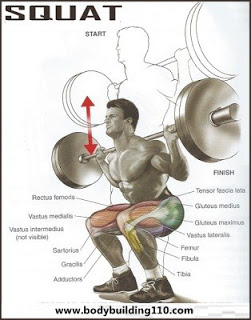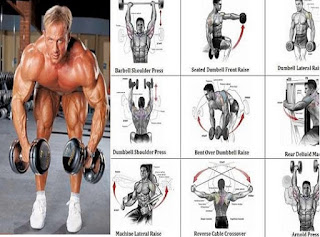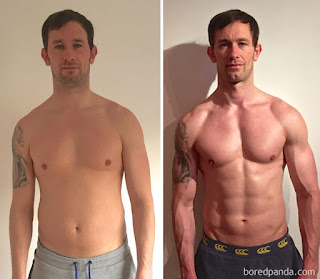8 Killer Tips To Boost Your Squat
Squats are lifting royalty for curing chicken leg syndrome’ and building high-performance muscle mass. Squats develop total-body strength, stimulate tons of total body muscle growth, and improve athleticism. Yep, the squat reigns king among bang-for-your buck exercises.
Problem is, most lifters have the mobility of a cast-iron skillet and lack the ability to squat safely and effectively. To maximize the squat you need the mobility to reach proper position and the stability to control movement through the intended range of motion.
It’s time to maximize your squat potential through improving technique, mobility, and execution. With these 8 tips you’ll take your squat performance to new levels.
1. WORK ON YOUR FORM, PERFECT IT
Just like any compound movement, proper form is critical in order to get results and avoid injury. You have two options when setting up for the squat: You can choose the high-bar or low-bar position.
High Bar
Placed on the upper traps
Torso remains upright
Low Bar
Placed on the rear deltoids
Slight bend at the hips
Hip-dominant
Experiment and decide which works best for you (remember to switch it up so that you don’t become dependent upon one form only), then prepare yourself to un-rack the weight.
How to Un-rack the Weight
Feet should be directly under the bar
Chest is up
Unrack (tip: don’t unrack the weight passively)
Step backward (one step on each foot)
Get in your stance
Tighten core
Head in neutral position
How to Descend
Push hips back WHILE bending the knees
Should feel as if you’re sitting back into a chair
Ensure the knees stay in line with your toes, try not to let your knees come out over your toes
Hit Depth (parallel at least, ideally get the hip just below the knee)
Explode to the top
2 .Train for Maximum Strength
Despite the fact you need to train heavy to build maximum strength, people often neglect heavy weights. Yes, training with submaximal loads will spare your joints and nervous system to a degree, but even to maximize submaximal training you need a base of absolute strength. Training at 60% 1RM for speed is much more effective when your 1RM is 1.5 to two-times your bodyweight.
Heavy lifting is generally defined as 85+% maximum effort for multiple sets of one to five reps. But it’s best to avoid missing lifts. Missing lifts consistently zaps your nervous system, engrains poor technique, and wrecks your confidence. Hit the reps you know you’ll make and save yourself for the occasional max-out attempts.
3 .SQUAT HEAVY
For beginners, stick with a basic strength template:
5 sets with a 3 to 6 rep range using 70% to 90% of your 1RM.
For more advanced lifters, try out the following program, this program will surely add poundage to your one rep max and beef up your legs in the process!
Week 1
(The total amount of squats during one workout)
5 sets of 2-3 repetitions at 90% of 1RM
2 sets of 4-6 (80-85% of 1 RM)
1 set of 12-15 (55-70% of 1RM)
Week 2
6 sets of 2-3 repetitions at 90% of 1RM
3 sets of 4-6 (80-85% of 1 RM)
1 set of 12-15 (55-70% of 1RM)
Week 3
6 sets of 2-3 repetitions at 90% of 1RM
4 sets of 4-6 (80-85% of 1 RM)
1 set of 12-15 (55-70% of 1RM)
Week 4
5 sets of 2-3 repetitions at 90% of 1RM
5 sets of 4-6 (80-85% of 1 RM)
2 set of 12-15 (55-70% of 1RM)
Week 5
1 set of 1 rep (1 Rep Max)
4 .GO DEEP
No, you can’t squat half depth. Yes, you may have to lower the weight. You need to go to at least parallel if you want solid results. Squatting deep will:
Build Size & Strength
Get the Glutes Firing
Strengthens Your Lower Back
Increases Power & Athleticism
5 .Rack at the Correct Height
We’ve all seen it: a rack set-up too high, a calf-raise walkout followed by the poor sap nearly cracking his skull when re-racking. Besides inappropriate barbell loading, improper rack set-up is the best way to get injured.
Set the rack up with the barbell set between nipple and shoulder height, low enough to allow you to squat to weight out and easily re-rack, as well.
6 .GET FLEXIBLE
In order to perfect your form, there is no way around making yourself more flexible. Flexibility helps you to take full advantage of the deep squat. Make stretching and flexibility exercises a part of your routine, especially when it comes to your hips.
Over time, you will notice that you are able to squat lower until you break the parallel plane. Practice your form and depth at home with bodyweight squats, practice makes perfect.
7 .GET THE RIGHT FOOTWEAR
There is a reason that companies spend thousands of dollars on research to craft the perfect shoe: They want you to be able to maximize your exercise potential.
Wearing the wrong shoes during a heavy squat session will not only unnecessarily increase the difficulty but also place you at risk for injury. Look for a shoe specifically made for olympic lifting or powerlifting.
8. PAUSE SQUATS WORK
If you really want to see results, try incorporating pause squats in your squat routine. Perform a squat as you normally would but instead of immediately ascending, stop at the bottom of the movement.
Hold yourself there for 3-5 seconds then stand up. Do this for every single rep. You’ll immediately feel the difference in your glutes, hamstrings, and hips. Try doing your heavy sets and finish off with highbar pause squats!
Problem is, most lifters have the mobility of a cast-iron skillet and lack the ability to squat safely and effectively. To maximize the squat you need the mobility to reach proper position and the stability to control movement through the intended range of motion.
It’s time to maximize your squat potential through improving technique, mobility, and execution. With these 8 tips you’ll take your squat performance to new levels.
1. WORK ON YOUR FORM, PERFECT IT
Just like any compound movement, proper form is critical in order to get results and avoid injury. You have two options when setting up for the squat: You can choose the high-bar or low-bar position.
High Bar
Placed on the upper traps
Torso remains upright
Low Bar
Placed on the rear deltoids
Slight bend at the hips
Hip-dominant
Experiment and decide which works best for you (remember to switch it up so that you don’t become dependent upon one form only), then prepare yourself to un-rack the weight.
How to Un-rack the Weight
Feet should be directly under the bar
Chest is up
Unrack (tip: don’t unrack the weight passively)
Step backward (one step on each foot)
Get in your stance
Tighten core
Head in neutral position
How to Descend
Push hips back WHILE bending the knees
Should feel as if you’re sitting back into a chair
Ensure the knees stay in line with your toes, try not to let your knees come out over your toes
Hit Depth (parallel at least, ideally get the hip just below the knee)
Explode to the top
2 .Train for Maximum Strength
Despite the fact you need to train heavy to build maximum strength, people often neglect heavy weights. Yes, training with submaximal loads will spare your joints and nervous system to a degree, but even to maximize submaximal training you need a base of absolute strength. Training at 60% 1RM for speed is much more effective when your 1RM is 1.5 to two-times your bodyweight.
Heavy lifting is generally defined as 85+% maximum effort for multiple sets of one to five reps. But it’s best to avoid missing lifts. Missing lifts consistently zaps your nervous system, engrains poor technique, and wrecks your confidence. Hit the reps you know you’ll make and save yourself for the occasional max-out attempts.
3 .SQUAT HEAVY
For beginners, stick with a basic strength template:
5 sets with a 3 to 6 rep range using 70% to 90% of your 1RM.
For more advanced lifters, try out the following program, this program will surely add poundage to your one rep max and beef up your legs in the process!
Week 1
(The total amount of squats during one workout)
5 sets of 2-3 repetitions at 90% of 1RM
2 sets of 4-6 (80-85% of 1 RM)
1 set of 12-15 (55-70% of 1RM)
Week 2
6 sets of 2-3 repetitions at 90% of 1RM
3 sets of 4-6 (80-85% of 1 RM)
1 set of 12-15 (55-70% of 1RM)
Week 3
6 sets of 2-3 repetitions at 90% of 1RM
4 sets of 4-6 (80-85% of 1 RM)
1 set of 12-15 (55-70% of 1RM)
Week 4
5 sets of 2-3 repetitions at 90% of 1RM
5 sets of 4-6 (80-85% of 1 RM)
2 set of 12-15 (55-70% of 1RM)
Week 5
1 set of 1 rep (1 Rep Max)
4 .GO DEEP
No, you can’t squat half depth. Yes, you may have to lower the weight. You need to go to at least parallel if you want solid results. Squatting deep will:
Build Size & Strength
Get the Glutes Firing
Strengthens Your Lower Back
Increases Power & Athleticism
5 .Rack at the Correct Height
We’ve all seen it: a rack set-up too high, a calf-raise walkout followed by the poor sap nearly cracking his skull when re-racking. Besides inappropriate barbell loading, improper rack set-up is the best way to get injured.
Set the rack up with the barbell set between nipple and shoulder height, low enough to allow you to squat to weight out and easily re-rack, as well.
6 .GET FLEXIBLE
In order to perfect your form, there is no way around making yourself more flexible. Flexibility helps you to take full advantage of the deep squat. Make stretching and flexibility exercises a part of your routine, especially when it comes to your hips.
Over time, you will notice that you are able to squat lower until you break the parallel plane. Practice your form and depth at home with bodyweight squats, practice makes perfect.
7 .GET THE RIGHT FOOTWEAR
There is a reason that companies spend thousands of dollars on research to craft the perfect shoe: They want you to be able to maximize your exercise potential.
Wearing the wrong shoes during a heavy squat session will not only unnecessarily increase the difficulty but also place you at risk for injury. Look for a shoe specifically made for olympic lifting or powerlifting.
8. PAUSE SQUATS WORK
If you really want to see results, try incorporating pause squats in your squat routine. Perform a squat as you normally would but instead of immediately ascending, stop at the bottom of the movement.
Hold yourself there for 3-5 seconds then stand up. Do this for every single rep. You’ll immediately feel the difference in your glutes, hamstrings, and hips. Try doing your heavy sets and finish off with highbar pause squats!




Commentaires
Enregistrer un commentaire